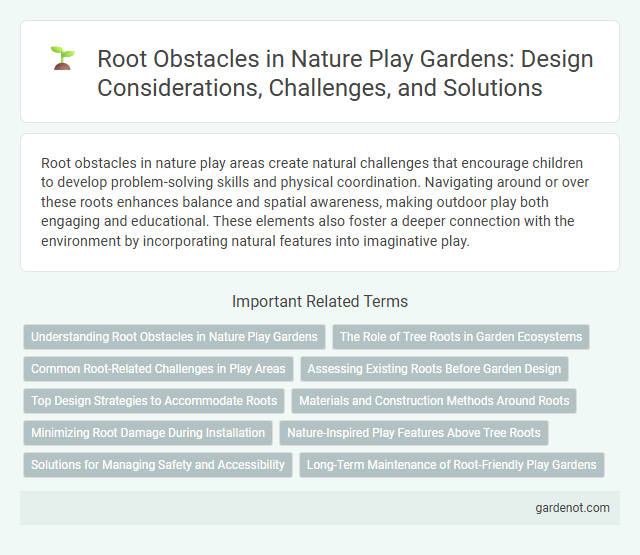Root obstacles in nature play areas create natural challenges that encourage children to develop problem-solving skills and physical coordination. Navigating around or over these roots enhances balance and spatial awareness, making outdoor play both engaging and educational. These elements also foster a deeper connection with the environment by incorporating natural features into imaginative play.
Understanding Root Obstacles in Nature Play Gardens
Root obstacles in nature play gardens commonly occur when tree roots interfere with play structures or pathways, presenting safety hazards and limiting design flexibility. Identifying these root systems early through soil analysis and root mapping enables effective planning to minimize damage and ensure the health of existing vegetation. Incorporating permeable paths and raised play elements can help preserve root zones while maintaining engaging and accessible play environments.
The Role of Tree Roots in Garden Ecosystems
Tree roots play a vital role in garden ecosystems by stabilizing soil, preventing erosion, and enhancing water retention. They create complex underground networks that support nutrient cycling and foster symbiotic relationships with beneficial microorganisms. This natural root structure can also act as root obstacles, encouraging diverse plant growth and promoting biodiversity within the garden environment.
Common Root-Related Challenges in Play Areas
Root obstacles in play areas often create uneven surfaces and tripping hazards, posing safety concerns for children. Tree roots can disrupt the integrity of playground equipment installation and hinder surface maintenance, reducing play area usability. Addressing root-related challenges requires strategic landscaping and innovative design solutions to ensure safe and engaging nature play environments.
Assessing Existing Roots Before Garden Design
Assessing existing roots is crucial before garden design to avoid damaging mature trees and ensure healthy plant growth. Root obstacles can limit planting options, requiring careful mapping and evaluation of root spread and depth. Understanding root structure helps optimize garden layout, promoting sustainable landscaping and preserving tree vitality.
Top Design Strategies to Accommodate Roots
Top design strategies to accommodate roots in nature play areas include creating elevated pathways and boardwalks that prevent root damage while allowing natural growth. Incorporating flexible surfacing materials like mulch or rubberized mats protects roots from compaction and erosion. Strategic placement of play equipment around major root systems ensures safety and preserves tree health by minimizing disturbance.
Materials and Construction Methods Around Roots
Materials used around tree roots in nature play areas must be porous and lightweight to avoid root suffocation and soil compaction. Construction methods prioritize minimal excavation and the use of boardwalks or raised platforms to protect root zones while allowing safe access. Incorporating mulch or permeable surfaces enhances water infiltration and root aeration, supporting tree health in play environments.
Minimizing Root Damage During Installation
Minimizing root damage during installation is crucial for preserving tree health and stability in nature play areas. Techniques such as careful excavation, using air spades, and avoiding heavy machinery near root zones help protect critical root systems from injury. Proper root management supports long-term growth and maintains the natural ecosystem integrity essential for play environments.
Nature-Inspired Play Features Above Tree Roots
Tree roots create natural obstacles that enhance nature-inspired play by encouraging children to navigate uneven surfaces and develop balance and coordination. These exposed roots offer tactile and sensory experiences, fostering imaginative exploration and physical challenge. Incorporating root obstacles in play areas supports gross motor skill development and promotes outdoor engagement.
Solutions for Managing Safety and Accessibility
Root obstacles in nature play areas can be effectively managed by implementing raised pathways and rubberized mats to ensure safe, non-slip access while preserving natural elements. Regular maintenance including root pruning and clear signage helps minimize tripping hazards and enhances accessibility for children with mobility challenges. Incorporating sensory-rich, tactile surfaces around roots supports inclusive play opportunities and balances safety with natural exploration.
Long-Term Maintenance of Root-Friendly Play Gardens
Root-friendly play gardens require careful long-term maintenance to prevent root obstacles from damaging trees and play structures. Regular root inspections and the use of permeable materials help sustain healthy root growth while minimizing soil compaction in play areas. Incorporating deep mulch layers and root barriers supports both tree health and safe, accessible play environments.
Root obstacle Infographic

 gardenot.com
gardenot.com